Elk
Cervus canadensis
Adult males can jump eight feet vertically
Advertisement
Elk Scientific Classification
- Kingdom
- Animalia
- Phylum
- Chordata
- Class
- Mammalia
- Order
- Artiodactyla
- Family
- Cervidae
- Genus
- Cervus
- Scientific Name
- Cervus canadensis
Read our Complete Guide to Classification of Animals.
Elk Conservation Status
Elk Facts
- Prey
- Baby ground-dwelling birds
- Name Of Young
- Calf
- Group Behavior
- Herd
- Fun Fact
- Adult males can jump eight feet vertically
- Estimated Population Size
- Unknown
- Biggest Threat
- Diseases, parasites
- Most Distinctive Feature
- Large male antlers and bugling sound
- Other Name(s)
- Wapiti, red deer
- Gestation Period
- 240-262 days
- Litter Size
- 1
- Habitat
- Mountain meadows, forests, forest edges
- Diet
- Omnivore
- Type
- Cervid
- Common Name
- Elk, wapiti
- Number Of Species
- 14
- Location
- North America, Central Asia, East Asia
- Group
- Herd or solitary
Elk Physical Characteristics
- Color
- Brown
- Skin Type
- Hair
- Top Speed
- 40 mph
- Lifespan
- 10-15 years in the wild, 20 years in captivity
- Weight
- 171-600kg (377-1,300lbs)
- Height
- 0.75-1.5m (2ft 6in-4ft 11in)
- Length
- 1.6-2.7m (5ft 3in-8ft 10in)
- Age of Sexual Maturity
- 16 months
- Age of Weaning
- 2 months
The elk, or wapiti, is one of the largest land-dwelling animals in North America, Central Asia, and East Asia, where it lives in mountain meadows, forests, and forest edges.

The elk is the second-largest wild herbivore, or cervid, after the moose. The Roosevelt’s elk, Tule elk, Rocky Mountain elk, and the Manitoban elk are four of the six North American subspecies that still exist in the wild, while the Eastern and the Merriam’s Easter elk subspecies are extinct.
Elk are popular as hunting game, while its meat is a specialty in some restaurants and stores, and its antlers are used in novelty items and traditional East Asian medicine. Although some herds suffer from infectious disease, the general population is increasing and listed as Least Concern on the IUCN Red List.
5 Incredible Facts!
- The male bugling sound is made from simultaneously roaring and whistling, as evidenced by their moving both their lips and their nostrils.
- Elk consume an average of 9.1kg (20lbs) of vegetation every day.
- Adult males (bulls) can run up to 40mph.
- The elk is the unofficial mascot of Estes Park, Colorado, since it is one of the most often spotted wildlife there.
- Wapiti (waapiti) is a word meaning “white rump” in Shawnee and Cree.
You can check out more incredible facts about elk.
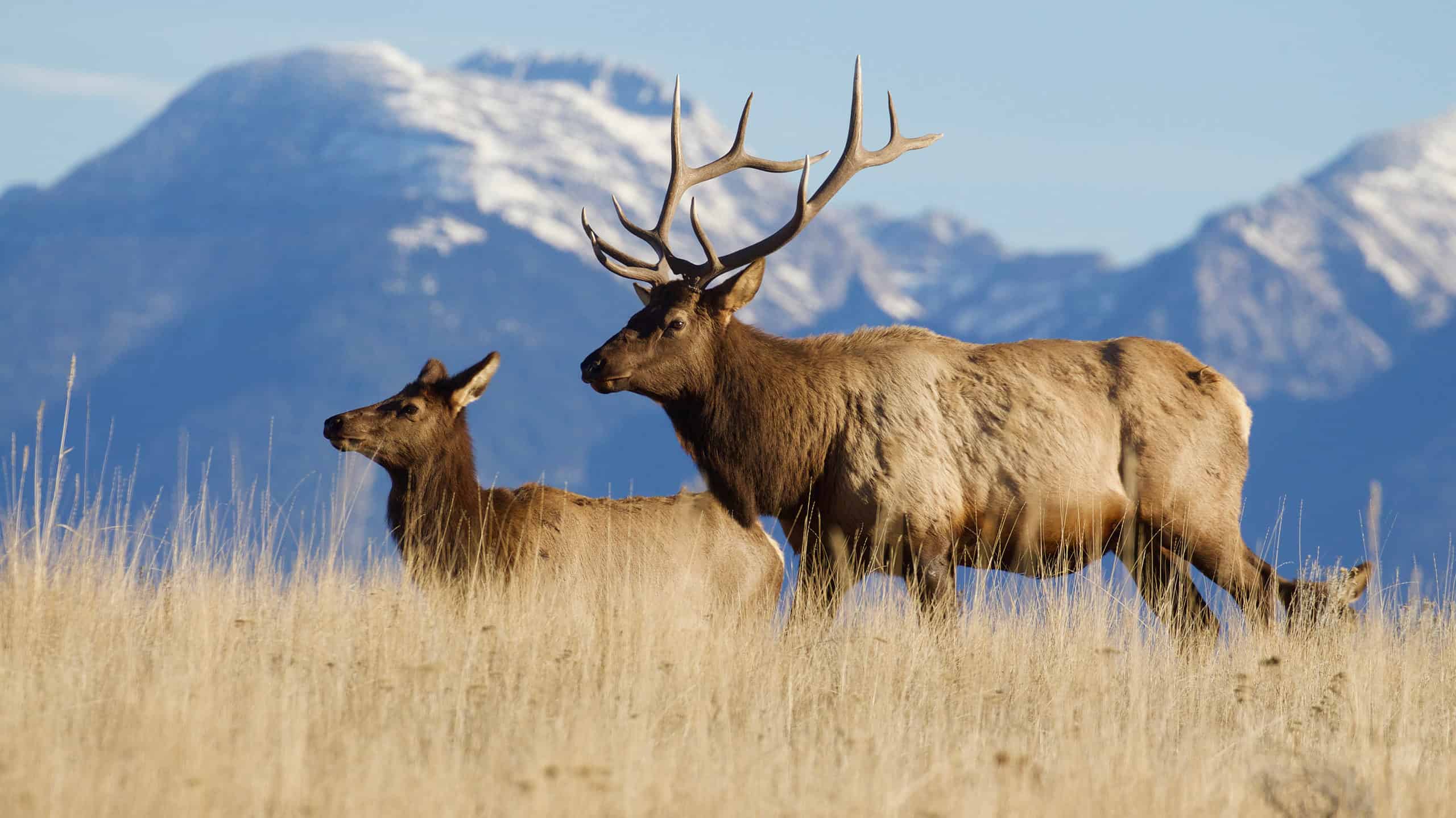
American Elk, male (with antlers) and female in front of the Rocky Mountains
©Tom Reichner/Shutterstock.com
Scientific Name and Origins
These animals are often confused with the moose, not only because they look similar but because the moose (scientific name Alces alces or Cervus alces) is called “elk” in Eurasia. The scientific name of the elk is Cervus canadensis, with C. c. canadensis being the species type. There are 14 subspecies. Although they are both animals in the deer family Cervidae, the elk are in the subfamily Cervinae or Old World Deer, while the moose is in the subfamily Capriolinae (Odocoileinae) or New World deer.
The word “elk” historically had a meaning like “large deer.” English-speaking people in North America in the 17th century were familiar with the elk’s relative, the red deer (Cervus elaphus) but not the moose, so they gave the name “elk” to Cervus canadensis, also referred to as “red deer.” Linguistically, the romanized ancient Greek word for the Latin Alces (moose) was álkē, which during the Early Middle Ages in the 8th century was called elch, elh and eolh in Old English. It then became elk, elcke or elke in Middle English or the Latinized alke. The Asian subspecies of elk are sometimes called maral, though the word mainly applies to the Caspian red deer, a red deer subspecies (Cervus elaphus maral).
Elk are related to an ancient breed of red deer in Asia, and are still called red deer there. They came to North America across the Bering Strait about 120,000 years ago, as did the caribou and other animals. Between 5,000 to 10,000 years ago, they advanced as far as Colorado, and there may have been as many as 10 million elk in North America when European settlement began.
Types
North American elk
- C. canadensis roosevelti (Roosevelt’s elk)
- C. canadensis nannodes (Tule elk)
- C. canadensis manitobensis (Manitoban elk)
- C. canadensis nelsoni (Rocky Mountain elk)
- C. canadensis canadensis (Eastern elk; extinct for over a century)
- C. canadensis merriami (Merriam’s Easter elk; extinct for over a century)
Eastern Asian elk (wapiti)
- C. c. sibiricus (Altai wapiti)
- C. c. songaricus (Tian Shan wapiti)
- C. c. xanthopygus (Manchurian wapiti)
- C. c. alashanicus (Alashan wapiti)
Central Asian red deer (Southern group)
- C. c. macneilli (Sichuan deer)
- C. c. kansuensis (Kansu red deer)
- C. c. wallichii (Tibetan red deer)
- C. c. hanglu (Kashmir stag)
Recent DNA studies indicate there are really no more than three or four subspecies, with the American forms and even the Siberian elk (C. canadensis sibiricus) all seeming to belong to one subspecies (C. canadensis canadensis). The Chinese subspecies are all treated as one distinct species.
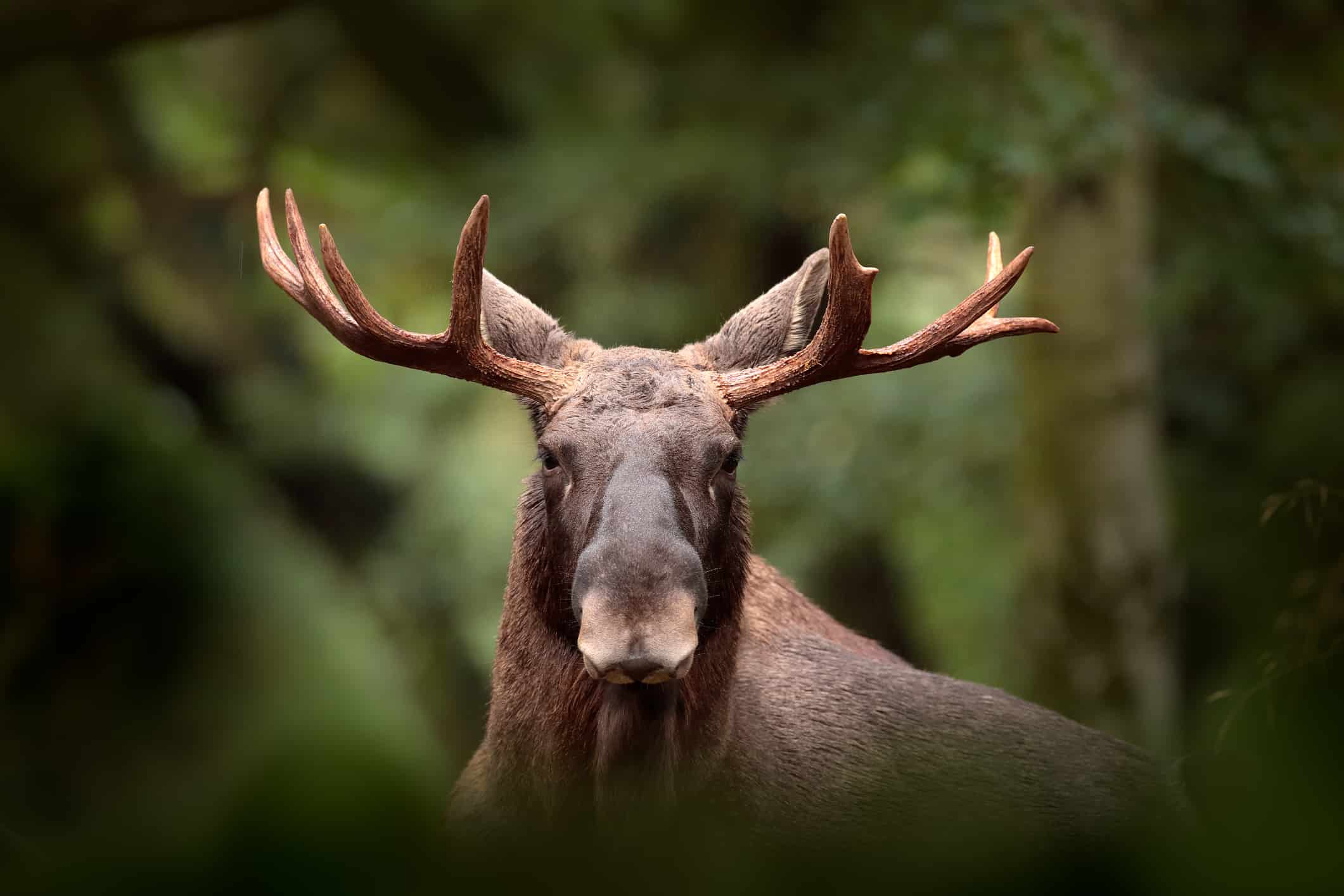
Elk males have large antlers coverd by a velvet that is shed in the summer.
©iStock.com/Ondrej Prosicky
Appearance
The 14 subspecies are all thought to be variations of the same species with slight differences in appearance and behavior known as climate-related lifestyle factors. All have thick bodies with short tails, small and defined rump patches, and slender legs. They have a shoulder height of 0.75-1.5m (2ft 6in-4ft 11in) with a nose-to-tail length of 1.6-2.7m (5ft 3in-8ft 10in). Males weigh 178-497kg (392-1,096lbs) while females weigh 171-292kg (377-644lbs).
The exception is the largest subspecies, Roosevelt’s elk, where the largest males can weigh up to 600kg (1,300lbs) but on average 318-499kg (701-1,100lbs) with females weighing 261-283kg (575-624lbs). Tule elk also have a different weight, with males weighing 204-318kg (450-701lbs) and females weighing 170-191kg (375-421lbs). All elk grow a thick winter coat during the fall, but only male and female North American elk have thin neck manes.
All male animals have antlers that are made of bone and grow 2.5cm, or about an inch a day. The antlers can grow over 20 inches in length! During growth, a layer of velvet covers them. They shed the velvet covering in the spring after the antlers are done developing. Since testosterone drives the formation of antlers, when the testosterone level drops in late winter and early spring, the antlers shed. Some antlers have multiple tines. North American and Siberian elk both have the largest antlers and the Altai wapiti has the smallest, with Roosevelt’s antlers weighing 18kg (40lbs).
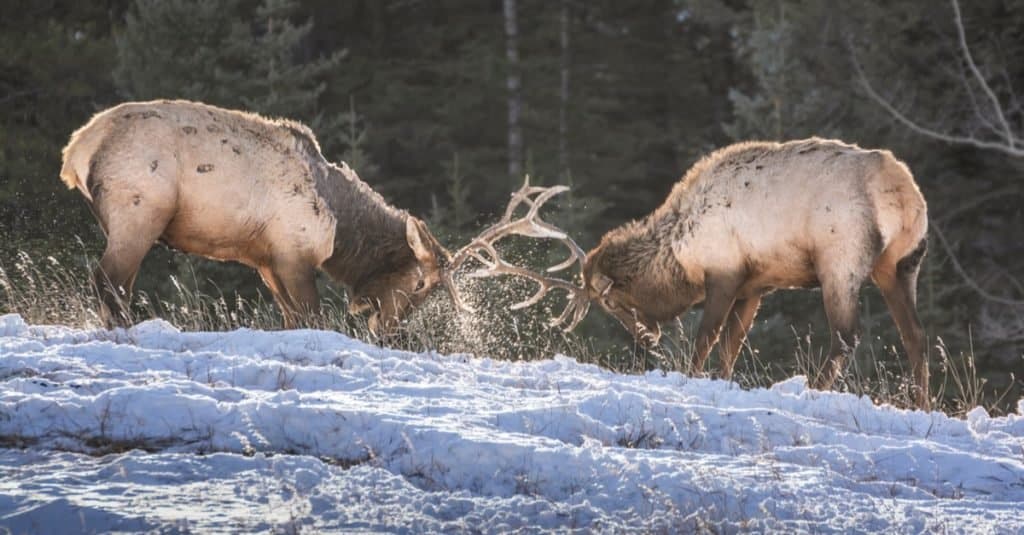
Sparring Elk in Banff National Park, Alberta, Canada.
©James Gabbert/Shutterstock.com
Behavior
Males are called bulls and female elk are called cows. These animals are some of the most social deer species, with group sizes during the summer reaching up to 400 individuals. Adult males and females segregate themselves into different herds during most of the year, with female herds being larger and males creating small groups or being solitary. Young bulls live in female herds or with older, less aggressive bulls.
During mating season, bulls engage in rutting behavior and compete for females which they include in harems of 20 or more cows. They try to intimidate rivals with bugling and antler displays, continuing on with antler wrestling. They may also dig wallows or holes in the ground to urinate in and roll themselves, giving them a unique smell to attract cows. Bulls also defend their harem from other males and predators and herd them when they stray from the harem.
The bulls’ vocalization, called bugling, can reach 4000 Hz. They do it by blowing air from the opening between the vocal folds (the glottis) through the nostrils. They can also create deeper pitched sounds of 150 Hz through the larynx.
Elk rub against trees and other objects to shed their winter coats by early summer. Like several deer species, they migrate into higher altitudes in the spring and retreat in the fall, creating summer and winter ranges. They travel up to 169mi (270km) during their longest migration in the continental U.S.
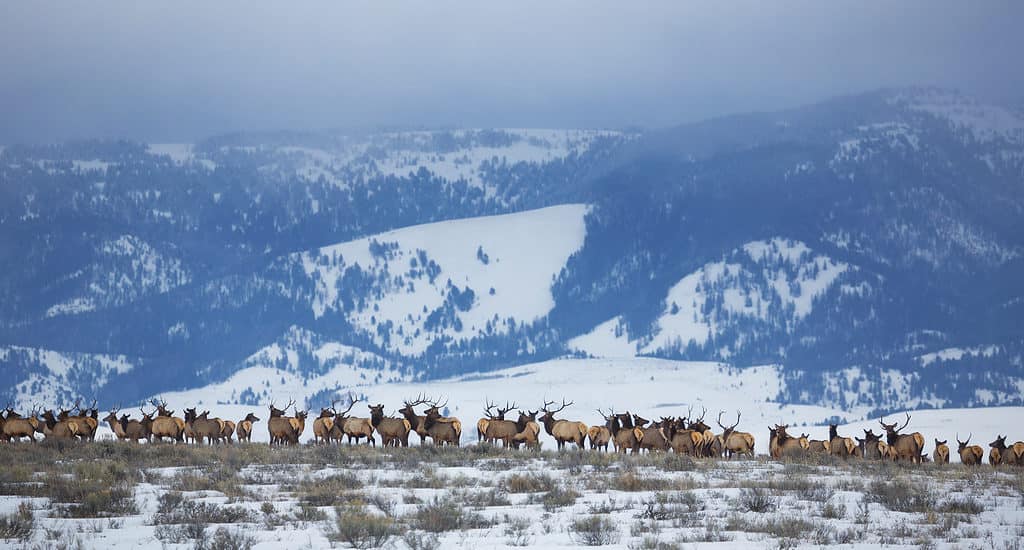
American elk have recovered in Colorado due to the efforts of local communities, conservationists, and hunters.
©Chase Dekker/Shutterstock.com
Habitat
The animal’s native habitat is Eastern Asia and North America but was introduced to Central Asia. It had a far wider habitat range in prehistoric times, which included Europe. The species lives in mountain meadows, forests, and forest edges.
There have been elk in New Zealand since 1909 when President Theodore Roosevelt made a gift of a herd of 20 animals that were released on the South Island. Now the elk are hunted as a commercial sport, but they are obviously classed as North American elk.
In addition, elk were introduced to Argentina in the early 1900s, but they are now considered an invasive species, competing for food with native animals.
Diet
As ruminants, these animals have four-chambered stomachs. But while moose and white-tailed deer are mainly browsers, elk are mainly grazers. They feed in the morning and evening and seek shelter to digest. During winter, they travel to wooded areas for greater availability of food. Their diets are herbivorous, consuming native grasses year-round, tree bark in winter, and shrubs and tree leaves and sprouts in summer. Each day they eat 9.1kg (20lbs) of vegetation on average.
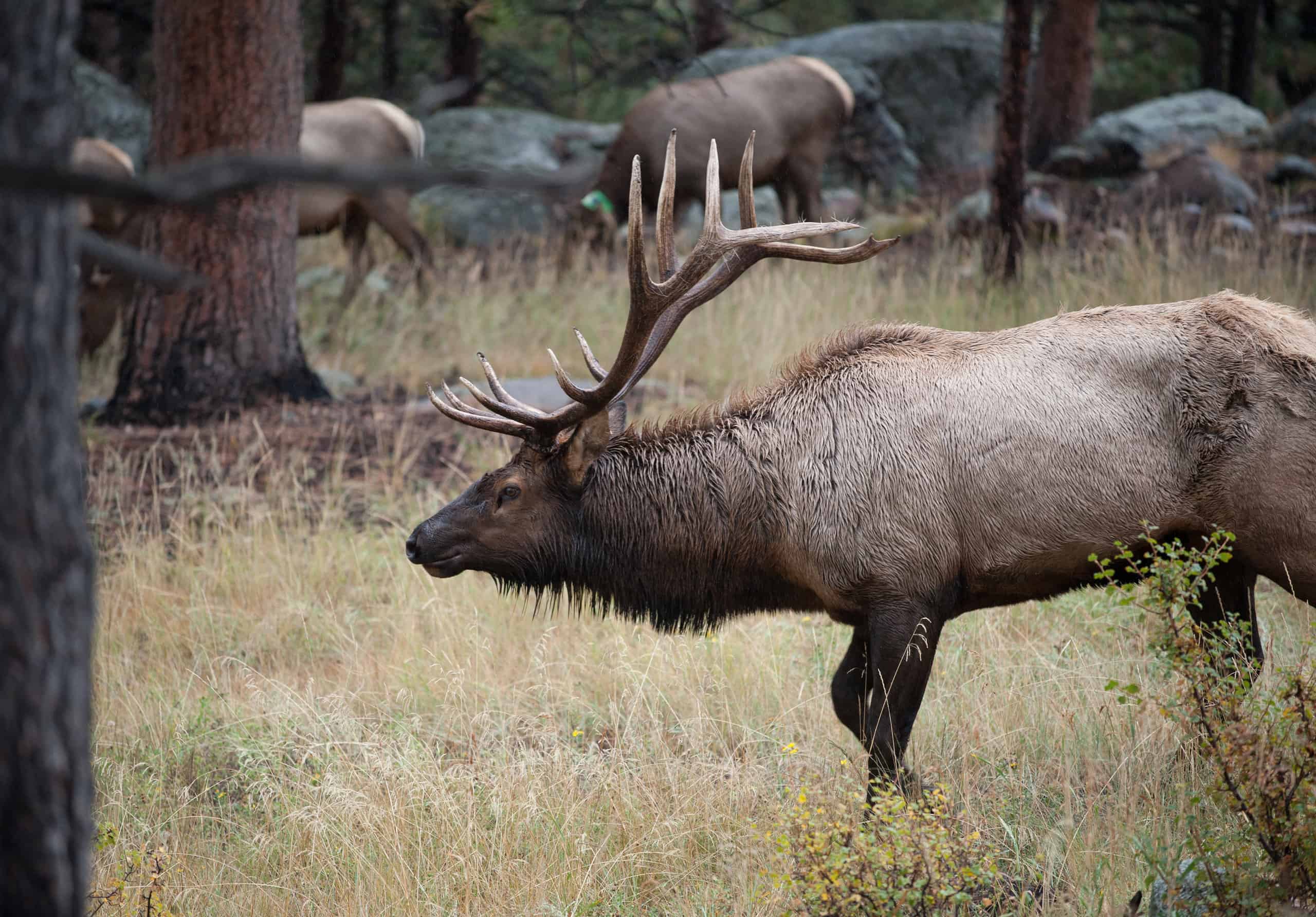
Elk have a number of predators among large mammals like bears, but they are also hunted by humans and attacked by diseases.
©Tony Campbell/Shutterstock.com
Predators and Threats
Typical predators of these animals are wolves, coyotes, brown bears, North American black bears, Asiatic black bears, cougars, and Siberian tigers. Coyote packs, brown bears, and black bears are the main predators of elk calves, with brown and black bears being the top predators. The killing of young cows affects population growth more than that of bulls or calves. Bulls are weakened by chasing females and fighting other males in late winter, or when they have lost their antlers, and so are more likely to be preyed upon by wolves then. However, elk can decrease predation by changing to browsing instead of grazing, the main difference being the change from wooded areas with their heads up to open areas with their heads down.
Other threats to these animals are several bacterial infectious diseases and parasites, with some being transmittable to livestock. The main host of the brainworm or meningeal worm (Parelaphostrongylus tenuis) is the white-tailed deer, which is not affected, but the worm is fatal for elk. Elk can also consume the same parasite through snails and slugs which are intermediate hosts.
Other fatal parasites are the liver fluke (Fascioloides magna) and the lungworm Dictyocaulus viviparus. The chronic wasting disease is transmitted by prions (pathogenic agents) and affects their brain tissue. It can be transmitted through consuming elk antler velvet, which in humans results in the variant Creutzfeldt–Jakob disease.
A bacterial disease called brucellosis in the U.S. only exists in Yellowstone. It can transmit to domesticated cattle, bison, and horses and cause infertility, spontaneous abortions, and decreased milk production. In humans, it results in undulant fever and flu-like symptoms which can persist for years. Gastrointestinal parasites include Eimeria sp. and Ostertagia sp. Another disease of concern is elk hoof disease, which is connected to treponeme bacteria and causes hoof deformities leading to extreme lameness.
For humans, elk are also not only a hunting game species, but their antlers are often used in traditional Chinese medicine, with antler velvet used as an aphrodisiac to increase well-being and testosterone for both men and women. The meat is available in some restaurants and grocery stores. It is higher in protein, lower in fat and cholesterol, and leaner than chicken, pork, and beef, as well as being a good source of zinc, phosphorus, and iron.
Antlers are also used in novelty items such as artwork and furniture, with elk being raised for their antlers by Asian peoples. North America and New Zealand have many elk farms. Native Americans engaged in hunting elk to use their hides for tepee coverings, clothing, and footwear.
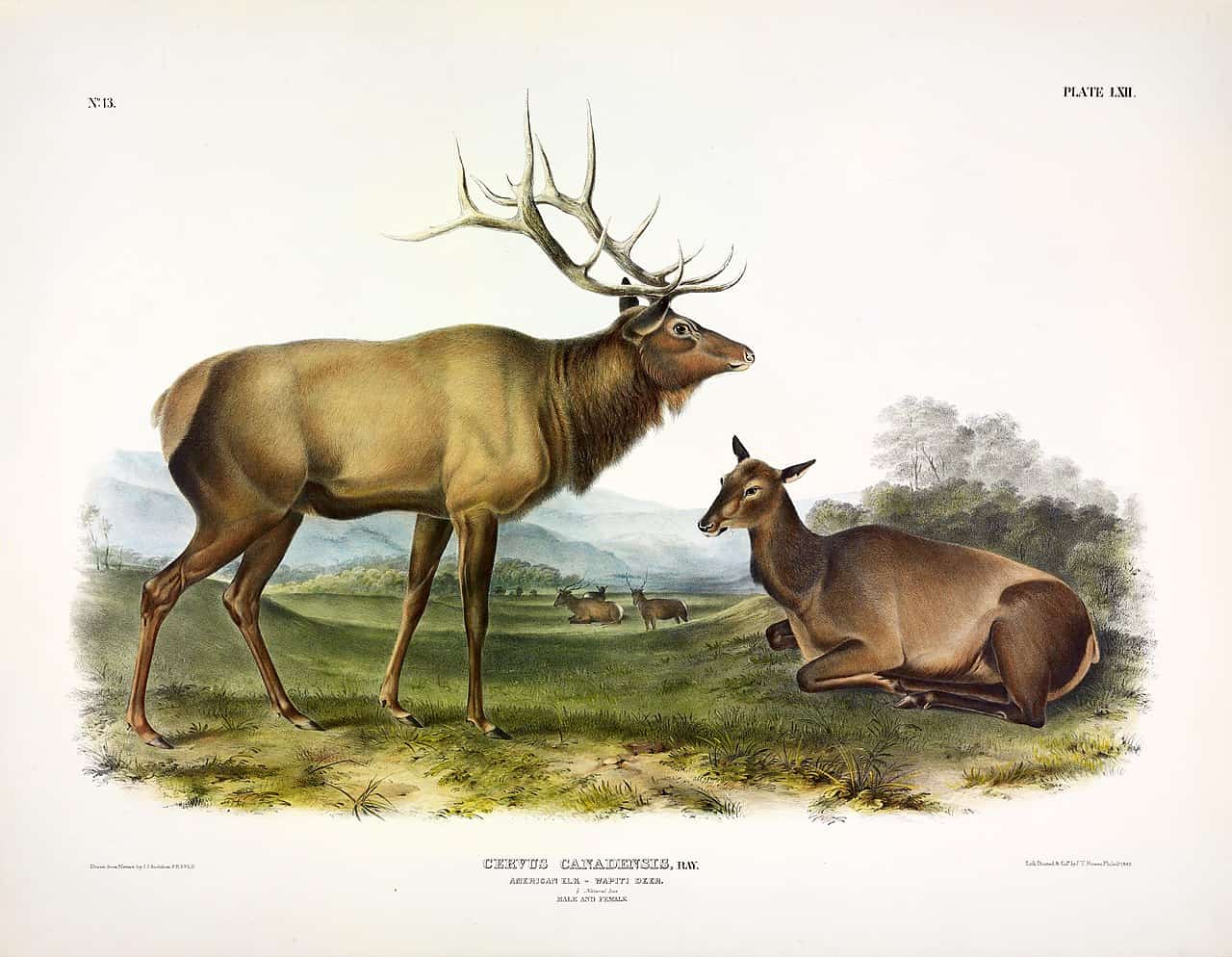
Cows usually produce only one calf at a time.
©John James Audubon / public domain – License
Reproduction and Life Cycle
Bulls and cows join each other during the mating season starting in late August and ending in early winter. Bulls make a dozen or more mating attempts during the cows’ short estrus lasting one or two days. Cows typically produce one, and occasionally two, offspring, which are called calves. Cows reproduce most often when they weigh at least 200kg (440lbs).
The gestation period is 240-262 days and the calves weigh between 15-16kg at birth. They are born with spots that they lose by the end of summer. Cows isolate themselves for birth and until the calf can flee from predators. Calves can join the herd after two weeks, and at two months are fully weaned. Before age three, elk leave their birth ranges. Their lifespan is 10-13 years and sometimes 15 years in the wild and 20 or more years in captivity.
Population
The population of elk herds in the Greater Yellowstone Ecosystem is about 40,000 individuals. There are 9,000-13,000 elk in the Teton herd, which migrate south from the southern parts of Yellowstone National Park and west from the Shoshone and Bridger-Teton National Forests to spend their winters on the National Elk Refuge. The population of Cervus canadensis is increasing and listed as Least Concern on the IUCN Red List.
View all 117 animals that start with EElk FAQs (Frequently Asked Questions)
What's the difference between elk and reindeer?
There are several important differences between elk and reindeer. Frist, elk are larger. Second, the two primarily live in different habitats, with reindeer surviving in much more northerly climates. Finally, reindeer have long been domesticated while elk are not domesticated.
What does elk taste like?
Its taste is a cross between venison and beef.
What do elk eat?
Native grasses, forbs, shrubs, tree bark, and twigs.
Where do elk live?
Mountain meadows, forests, and forest edges.
Is an elk a moose?
No. Although they look similar and are both members of Cervidae (the deer family), they are in different subfamilies.
Why are elk dangerous?
Elk are dangerous in large part due to the bulls’ antlers which can impale their targets. They are also very heavy. Cows are dangerous during calving season, during which they are unpredictable and erratic, charging and stomping on animals they perceive as a threat.
Do elk eat meat?
They may occasionally eat eggs and baby ground-dwelling birds such as goslings.
Are elk carnivores, herbivores or omnivores?
Elk are herbivores. However, they can also be opportunistic carnivores, which would make them omnivores.
What is the difference between a red stag and an elk?
The most notable difference is their size. Elk are much larger than the average red deer in size and pure mass. While there are some subspecies of red deer that come close (the central Asian red deer, for example), elk are generally larger. Aside from size, elk and red deer don’t share a common range: elk are found in North America, while red stags are found across Europe, North Africa, and some of the middle east. Both species have been introduced to various habitats around the world.
What are the differences between a sambar deer and an elk?
The greatest differences between a sambar deer and an elk are found in their morphology and range. Elk are large members of the deer family with a tan-colored body, a white rump patch and light hindquarters, a shaggy mane in the fall, and a small, short tail, but sambar deer have amber or yellow-brown coats, a black tail with a light underside that measures several inches, and a somewhat sparse mane. Elk are found throughout North America, parts of Asia, and parts of southeast Russia, but Sambar deer live throughout Southeast Asia and the Indian subcontinent.
Thank you for reading! Have some feedback for us? Contact the AZ Animals editorial team.
Sources
- Wikipedia, Available here: https://en.wikipedia.org/wiki/Elk
- Rocky Mountain National Park, Available here: https://www.visitestespark.com/blog/post/8-fascinating-facts-about-elk/
- Fossil Farms, Available here: https://www.fossilfarms.com/collections/north-american-elk
- Animalia, Available here: https://animalia.bio/elk

















